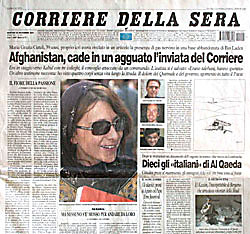
| Fit To Print |
 |
followthemedia.com - a knowledge base for media professionals |
|
|
AGENDA
|
||||
Italian Newspapers Have It Right — Sell Those Giveaways; The British Have It Wrong — They Give Away the Giveaways!British media learned long ago that circulation can increase by six figures overnight by wrapping free CDs, DVDs, computer games and the like with the publication. But once the giveaway promotion stops then sales often return to previous territory. The Italians have a smarter idea -- make money on the giveaways by selling them instead of giving them away. In fact, they usually do much better financially from selling the giveaways than they do from additional single copy sales!Two recent case histories help prove the point. In the UK the new tabloid Times’ goal was to increase circulation dramatically, particularly on Saturday. The major investments were giving away a free DVD movie on two successive November Saturdays via a covermount. In Italy, Corriere della Sera’s goal was to earn additional income by producing an additional product it could SELL to its readership with its newspaper. Using as a peg the reopening of Milan’s beloved La Scala, closed three years for refurbishment, the Milan newspaper produced six DVD operas, one to be sold each week as additions when buying the newspaper.
The Times did well with its DVDs. Circulation on those two Saturdays increased some 20%. But competitors now claim that when the promotion ended, down went the circulation again. The Times said it had an excellent November but hasn’t yet given a comparison of a DVD Saturday with a non-DVD Saturday. The obvious question is whether such giveaway promotions stick? Are giveaways in fact a marketer’s nightmare – that the newspaper was bought just to get the free DVDs, and once the DVDs end so does that newspaper sale? Previous UK experience has shown that such giveaways usually provide temporary circulation gains – people buy the product not for the newspaper but rather the covermount. Although it depends on how much advertising is bought to promote a covermount the rule of thumb is an average cost of such a giveaway is about ?250,000. If the publication makes make that much or more from its increased sales and advertising rates then it at least breaks even. 
The Times, however, is talking about an increase of some 125,000 for those two Saturday promotions which means it paid a lot of money to woo those new customers for those two weeks. If they don’t stick around without the DVD then that will be a lot of money down the drain. Back in Italy, the idea is to make money, a lot of money, from promotions and therefore they do it very frequently. The promotions do little for adding circulation. But they contribute a whole lot to the bottom line. Although it is too early to say how much Corriere della Sera will earn from the opera DVDs, the RCS group, which publishes the newspaper, says that similar projects have already earned €147 million this year alone. 
The newspaper, with a circulation of some 690,000, has produced already this year a series of 30 poetry books, each one selling around 200,000 copies when it goes on sale each Monday as an optional addition to the newspaper. It has produced a 14-volume History of Italy that sold some 370,000 copies per volume. And the newspaper has given a new meaning to convergence – the editorial culture department writes reviews on the items for sale. The actual marketing idea is not new. US supermarkets, for instance, often held promotions to sell low cost, multi-volume encyclopedias with a new volume available each week. The first volume was free or some ridiculous price like 99 cents to hook the shopper, and succeeding volumes were priced low on condition of a minimum grocery spend. Because there were around 25-30 volumes it kept the shoppers coming back to the supermarket each week – or in newspaper terms – it grew circulation which stayed until at least the promotion ended and because it was a long promotion they made good money on the cover price (the shopper coming back to the store each week to do grocery shopping) and they made some money on the books, too. Corriere della Sera started the Italian newspaper fad, and it didn’t take long for most of the other publishing houses to do the same. Such projects now result in annual revenue increases approaching 20% for the major newspaper publishing groups. Very welcome in an environment where advertising revenues have not recovered fully.
In 2003, for instance, Gruppo Editoriale L’Expresso, publisher of the leading Rome newspaper, La Repubblica, and the leading news weekly L’Espresso, said it sold in such promotional add-ons to their regular publications some 34 million books, 2 million DVDs, and 1.6 million CDs, resulting in a net profit increase of 47%. Most of the Italian promotions are books, based on the belief that since people buy newspapers to read, then perhaps they might buy something else to read, too. Back in the UK, hardly a weekend goes by that newspapers are not paying fortunes in promotional costs to give away something to watch or listen to (not often to read) in the hope of hanging on to circulations which, for the most part, are falling dramatically each month. For the hundreds of thousands of pounds UK publishers pay for their weekly giveaways, it might not be a bad idea to divert a few of those pounds to sending some of their marketing people on a trip to Italy. Now that could be money well spent! |
| copyright ©2004 ftm publishing, unless otherwise noted | Contact Us • Advertise with us |